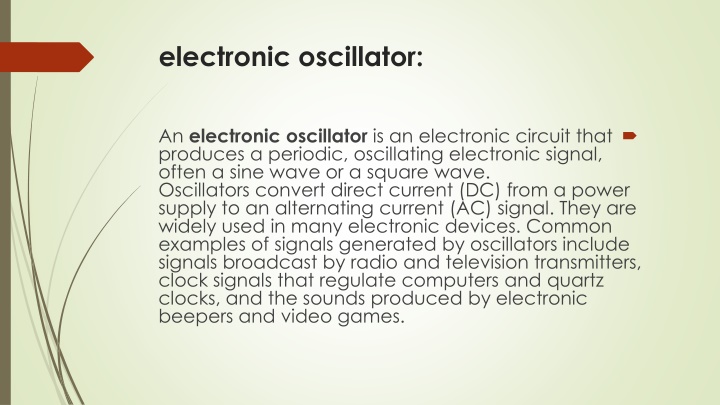
Electronic Oscillators: Types and Applications
Learn about electronic oscillators, essential circuits that produce periodic signals like sine waves. Explore different types, such as low-frequency oscillators and quartz crystal-based oscillators, and their applications in various electronic devices.
Download Presentation

Please find below an Image/Link to download the presentation.
The content on the website is provided AS IS for your information and personal use only. It may not be sold, licensed, or shared on other websites without obtaining consent from the author. If you encounter any issues during the download, it is possible that the publisher has removed the file from their server.
You are allowed to download the files provided on this website for personal or commercial use, subject to the condition that they are used lawfully. All files are the property of their respective owners.
The content on the website is provided AS IS for your information and personal use only. It may not be sold, licensed, or shared on other websites without obtaining consent from the author.
E N D
Presentation Transcript
electronic oscillator: An electronic oscillator is an electronic circuit that produces a periodic, oscillating electronic signal, often a sine wave or a square wave. Oscillators convert direct current (DC) from a power supply to an alternating current (AC) signal. They are widely used in many electronic devices. Common examples of signals generated by oscillators include signals broadcast by radio and television transmitters, clock signals that regulate computers and quartz clocks, and the sounds produced by electronic beepers and video games.
electronic oscillator: https://upload.wikimedia.org/wikipedia/commons/thumb/1/15/OpAmpHystereticOscillator.svg/220px-OpAmpHystereticOscillator.svg.png A popular op-amp relaxation oscillator.
electronic oscillator: A low-frequency oscillator (LFO) is an electronic oscillator that generates a frequency below approximately 20 Hz. This term is typically used in the field of audio synthesizers, to distinguish it from an audio frequency oscillator. An audio oscillator produces frequencies in the audio range, about 16 Hz to 20 kHz. An RF oscillator produces signals in the radio frequency (RF) range of about 100 kHz to 100 GHz.
electronic oscillator: 1 MHz electronic oscillator circuit which uses the resonant properties of an internal quartz crystal to control the frequency. Provides the clock signal for digital devices such as computers.
Feedback oscillator: The most common form of linear oscillator is an electronic amplifier such as a transistor or operational amplifier connected in a feedback loop with its output fed back into its input through a frequency selective electronic filter to provide positive feedback. When the power supply to the amplifier is first switched on, electronic noise in the circuit provides a non-zero signal to get oscillations started. The noise travels around the loop and is amplified and filtered until very quickly it converges on a sine wave at a single frequency.
Feedback oscillator: Block diagram of a feedback linear oscillator; an amplifier A with its output vofed back into its input vfthrough a filter, (j ).
Feedback oscillator: Two common LC oscillator circuits, the Hartley and Colpitts oscillators
Negative-resistance oscillator: In addition to the feedback oscillators described above, which use two-port amplifying active elements such as transistors and operational amplifiers, linear oscillators can also be built using one-port (two terminal) devices with negative resistance, such as magnetron tubes, tunnel diodes, IMPATT diodes and Gunn diodes. Negative- resistance oscillators are usually used at high frequencies in the microwave range and above, since at these frequencies feedback oscillators perform poorly due to excessive phase shift in the feedback path.
Negative-resistance oscillator: https://upload.wikimedia.org/wikipedia/commons/thumb/4/46/Negative_resistance_oscillator.svg/190px-Negative_resistance_oscillator.svg.png https://upload.wikimedia.org/wikipedia/commons/thumb/d/d4/Ganna_gjenerators_M31102-1.jpg/162px-Ganna_gjenerators_M31102-1.jpg (left) Typical block diagram of a negative resistance oscillator. In some types the negative resistance device is connected in parallel with the resonant circuit. (right) A negative-resistance microwave oscillator consisting of a Gunn diode in a cavity resonator. The negative resistance of the diode excites microwave oscillations in the cavity, which radiate out the aperture into a waveguide.















